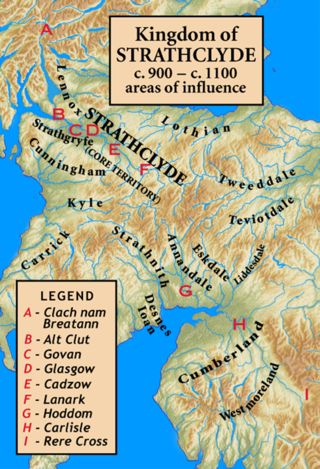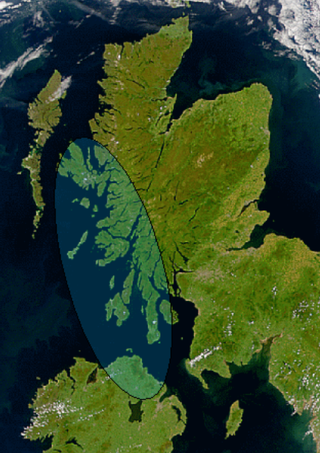Related Research Articles

Strathclyde was a Brittonic kingdom in northern Britain during the Middle Ages. It comprised parts of what is now southern Scotland and North West England, a region the Welsh tribes referred to as Yr Hen Ogledd. At its greatest extent in the 10th century, it stretched from Loch Lomond to the River Eamont at Penrith. Strathclyde seems to have been annexed by the Goidelic -speaking Kingdom of Alba in the 11th century, becoming part of the emerging Kingdom of Scotland.

Áedán mac Gabráin, also written as Aedan, was a king of Dál Riata from c. 574 until c. 609 AD. The kingdom of Dál Riata was situated in modern Argyll and Bute, Scotland, and parts of County Antrim, Ireland. Genealogies record that Áedán was a son of Gabrán mac Domangairt.

Rhodri Molwynog, also known as Rhodri ap Idwal was an 8th century king of Gwynedd. He was listed as a King of the Britons by the Annals of Wales.

Bridei son of Beli, died 692 was king of Fortriu and of the Picts from 671 until 692. His reign marks the start of the period known to historians as the Verturian hegemony, a turning point in the history of Scotland, when the uniting of Pictish provinces under the over-kingship of the kings of Fortriu saw the development of a strong Pictish state and identity encompassing most of the peoples north of the Forth.
Dyfnwal Hen or Dumnagual Hen was a ruler of the Brittonic kingdom of Alt Clut, later known as Strathclyde, probably sometime in the early 6th century. His biography is vague, but he was regarded as an important ancestor figure for several kingly lines in the Hen Ogledd or "Old North" of Britain. As an ancestor figure, he compares to Coel Hen, another obscure figure credited with founding a number of northern dynasties.
Clinoch is thought to have been a ruler of Alt Clut, the Brittonic kingdom later known as Strathclyde, some time in the 6th century. The Harleian genealogies name Clinoch as the son of Dumnagual Hen, his probable predecessor as King of Alt Clut, and the father of Tutagual, his probable successor. The Bonedd Gwŷr y Gogledd, a later genealogy of rulers in the Hen Ogledd or "Old North" of Britain, names the descendant between Dumnagual and Tutagual, Kedic.
Tutagual is thought to have been a ruler of the kingdom of Alt Clut, later known as Strathclyde, a Brittonic kingdom in the Hen Ogledd or "Old North" of Britain. He probably ruled sometime in the mid-6th century.
Neithon son of Guipno was a 7th-century ruler of Alt Clut, a Brittonic kingdom based on Dumbarton Rock. According to the Harleian genealogies, he was the son of Guipno map Dumnagual Hen. Alfred Smyth suggests he is the same man as King Nechtan the Great of the Picts, and perhaps the Nechtan son of Canu the Annals of Ulster record as having died in 621. The Senchus fer n-Alban indicate that Gartnait, the son of Áedán mac Gabráin, King of Dál Riata, sired a son named Cano, but unless the Harleian genealogies are to be ignored, this would make Gartnait and Dumnagual Hen the same persons, as the respective fathers of Gartnait and Guipno. However, it is possible that either as an Alt Clut Briton ascending the throne of Pictland, or as a Pict ascending the throne of Alt Clut, his genealogy might have been altered, and it is notable that in the Pictish king-lists he is called "Nechtan, nepos Uerb", suggesting that it was a descent from Uerb that mattered in Pictland, and not his unimportant father Guipno/Canu. Alan Orr Anderson pointed out that Uerb is probably the Pictish form of Ferb, a female name. Alan MacQuarrie suggests that Neithon was indeed the Pictish king Nechtan, but does not take any stance on the Guipno/Canu problem.
Beli I was a ruler of Alt Clut, a Brittonic kingdom based on Dumbarton Rock, some time in the 7th century. Very little is known of him, but his family appears to have been very well connected in northern Britain.
Eugein or Ywain was a ruler of Alt Clut, a Brittonic kingdom based on Dumbarton Rock, sometime in the mid-7th century. According to the Harleian genealogies, he was the son of Beli I, presumably his predecessor as king, and the father of Elfin, who ruled sometime later. The Annals of Ulster and the Annals of Tigernach record another probable son, Dumnagual, who ruled Alt Clut and died in 694. Eugein was probably the brother or half brother of Bridei III of the Picts, the victor at the Battle of Dun Nechtain.
Guret was a ruler of Alt Clut, a Brittonic kingdom based on Dumbarton Rock, during the mid-7th century. He is known only from an obituary note in the Annals of Ulster, which records Mors Gureit regis Alo Cluathe under the year 658. He is absent from the Harleian genealogies, which record the names of many other kings of Alt Clut. Historian Alan MacQuarrie suggests that he may have been an otherwise unrecorded brother, or perhaps son, of Eugein I of Alt Clut.
Elfin was a ruler of Alt Clut, a Brittonic kingdom based on Dumbarton Rock, sometime in the later 7th century. According to the Harleian genealogies, he was the son of Eugein I, one of his predecessors as king, and the father of Beli II, who ruled some time later. Very little is certainly known of him, though he may be identifiable with other figures attested in the Irish annals, and circumstantial evidence may link him to a number of important events during this time.
Dumnagual II was a ruler of Alt Clut, a Brittonic kingdom based on Dumbarton Rock, for some time in the late seventh century. He is known only from his death notice in the Irish annals. The Annals of Ulster, under the year 694, has Domnall m. Auin, rex Alo Cluathe, moritur. Dumnagual is the Old Welsh equivalent of Domnall, and Aun is certainly Eugein, probably to be identified with King Eugein I of Alt Clut.
Teudebur of Alt Clut was the ruler of Alt Clut, in the early-to-mid eighth century. According to the Harleian genealogies, he was the son of Beli II, his probable predecessor as king. Such information is confirmed by both the Irish and Welsh annals. We know from the Harleian genealogy that he was the father of Dumnagual III, one of his successors. His reign coincided with that of the illustrious Pictish king Óengus mac Fergusa. The Annales Cambriae reports that in 750, the Britons defeated a Pictish army at Mocetauc (Mygedawc), in which, according to the Annals of Tigernach, Óengus' brother Talorgen was killed. Mygedawc is often identified with modern Mugdock, on the boundary between Dunbartonshire and Stirlingshire, but this identity is by no means certain. The Annals of Tigernach, which styles him Taudar mac Bile, rí Alo Cluaide, put his death at 752, and for this reason, we can be certain Teudebur was the British king responsible for the British victory.
Dumnagual III was a king of Strathclyde in the mid-eighth century. According to the Harleian genealogies, he was the son of Teudebur, one of his predecessors.
Eugein II may have been ruler of Alt Clut, the Brittonic kingdom later known as Strathclyde, for some time in the late-8th century. He is known only from the Harleian genealogies, which indicate that he was the son of King Dumnagual III of Alt Clut; there is no direct evidence that he ruled as king himself. Dumnagual is presumed to be the monarch who submitted to the joint army of Kings Óengus I of the Picts and Eadberht of Northumbria in 756; after this event, Alt Clut seems to have remained under foreign power and the royal line is known exclusively through the Harleian genealogies for more than a century. If Eugein was king, he may have been in power during the "burning of Ail Cluaithe" recorded in the Annals of Ulster as having occurred in 780. According to Harleian, he was the father of Riderch II.
Riderch II was, according to the Harleian genealogies, the son of Eugein II, the son of King Dumnagual III of Alt Clut. He is known only from this source, and there is no direct evidence he was king of Alt Clut, although he is usually regarded as such by scholars. The Harleian genealogies indicate he was the father of Dumnugual IV, evidently his successor as king.
Dumnagual IV was a 9th-century British figure thought to have been a ruler of Alt Clut, the kingdom later known as Strathclyde. According to the Harleian genealogies, he was the son of his predecessor Riderch II, the grandson of Eugein II, and the great-grandson of King Dumnagual III of Alt Clut. He is known only from this source, and there is no direct evidence he was king of Alt Clut, although he is usually regarded as such by scholars. The Chronicle of the Kings of Alba reports the burning of Dunblane by the Britons in the year 849, and it is possible that Dumnagual was the British ruler responsible for the act, though it is equally possible that his son Artgal was responsible.
Arthgal ap Dyfnwal was a ninth-century king of Alt Clut. He descended from a long line of rulers of the British Kingdom of Alt Clut. Either he or his father, Dyfnwal ap Rhydderch, King of Alt Clut, may have reigned when the Britons are recorded to have burned the Pictish ecclesiastical site of Dunblane in 849.
References
- MacQuarrie, Alan, "The Kings of Strathclyde", in A. Grant & K.Stringer (eds.) Medieval Scotland: Crown, Lordship and Community, Essays Presented to G.W.S. Barrow, (Edinburgh, 1993), pp. 1–19